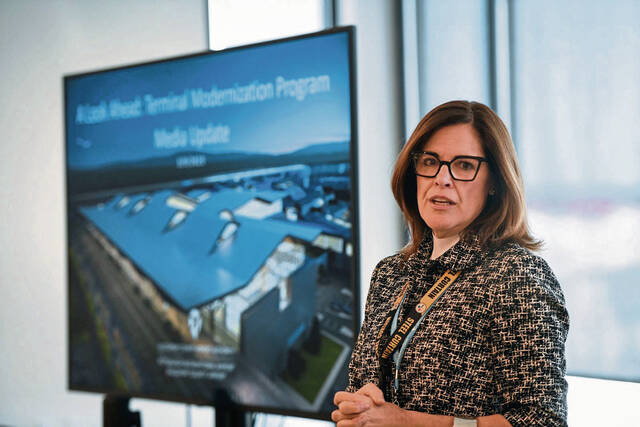Colin McNickle: Cassotis’ ‘facts’ and PIT’s realities
“Facts are stubborn things,” Founding Father John Adams reminded. “And whatever may be our wishes, our inclinations, or the dictates of our passion, they cannot alter the state of facts and evidence.”
Allegheny County Airport Authority CEO Christina Cassotis would be wise to recall that astute axiom the next time she touts to her board of directors the latest “rosy” passenger numbers at Pittsburgh International Airport (PIT).
As Jake Haulk, president-emeritus of the Pittsburgh think tank, notes it was in a March 15 newspaper article that reported Cassotis told board members that PIT’s still not publicly posted February passenger count of 646,000 had finally exceeded the pre-pandemic February 2019 number.
“We have finally beaten the 100% number,” she said. “I look forward to not comparing us to 2019 anymore soon.”
“(T)here are two major problems with that statement,” Haulk counters. “One, the February pre-pandemic passenger count at PIT has not been surpassed. And two, PIT’s post-pandemic bounce is far slower than the national upturn.
“And even though PIT’s passenger count began to recover following the pandemic, the longer-term gains are lagging far behind national growth and gains at fast-growing airports.”
The Ph.D. economist says the claim that pre-pandemic levels of 2019 have been reached or surpassed by the February 2024 posting of 646,000 passengers (enplaned and deplaned) ignores two important points:
“First, the highest February reading prior to the full impact of covid occurred in 2020, not 2019,” Haulk reminds. “Second, 2020 and 2024 are leap years with 29 days in February.
“When the 2019, 2020 and 2024 February readings are converted to a daily average basis, the 2024 count is 1.93% lower than 2019 and 4.6% lower than February 2020,” he calculates.
Haulk says even if PIT manages in the next few months to actually — and factually — exceed those 2019 passenger levels, “that is not exactly a reason for breaking out the champagne.”
“PIT has lost ground in national rankings” — it ranked 49th busiest in 2022 — “and its long-term passenger growth is woefully short of the national increase and at many airports around the country,” Haulk says.
And while the think tank scholar reminds that PIT is not alone in struggling to increase passenger traffic, “there are airports in similarly sized metro areas relative to the Pittsburgh market that are seeing much stronger demand growth than PIT.”
Indianapolis had a gain of 18% over the period from 2012 to 2022; the passenger count in Columbus was up 16.6%(although it has slipped slightly from 2017’s reading); Cincinnati posted a 25% increase in the same 10-year period and Raleigh-Durham climbed 30%.
“Truly impressive 10-year growth occurred in Nashville with a jump of 104% to rank 29th busiest,” Haulk says. “In Austin, enplanements climbed 125% over the 10 years, lifting the airport to the nation’s 27th busiest.”
Indeed, there are a number of variables that must be considered, including “the loss or expansion of hubbing activity, the performance of the regional economy served by the airport and factors affecting attractiveness or cost of operating at the airports, among others,” Haulk says.
PIT has not been a hub for decades, its operating costs are high, the economy has been perpetually anemic and “population growth” continues to be a non sequitur.
“A region such as the Pittsburgh MSA, that is very slow growing or has yet to recover from covid employment losses, has population stagnation and a very high-cost airport will find itself leaning more and more on non-passenger or freight-related activity,” Haulk says.
“The airport will increasingly rely on taxpayer financial assistance such as the $12 million allocation of gaming revenue at PIT and the royalties on gas extracted from airport property that obviously cannot be relied on in perpetuity.”
Haulk concludes that airports, unless they are hubs, are not principal economic drivers for the region they serve.
“They are infrastructure that is integral to a modern economy that facilitates area growth. It would be well to bear that in mind,” he cautions.
Christina Cassotis fails to heed those stubborn facts at her own, and taxpayers’, great disappointment.
Colin McNickle is communications and marketing director at the Allegheny Institute for Public Policy and can be reached via email.
Remove the ads from your TribLIVE reading experience but still support the journalists who create the content with TribLIVE Ad-Free.

